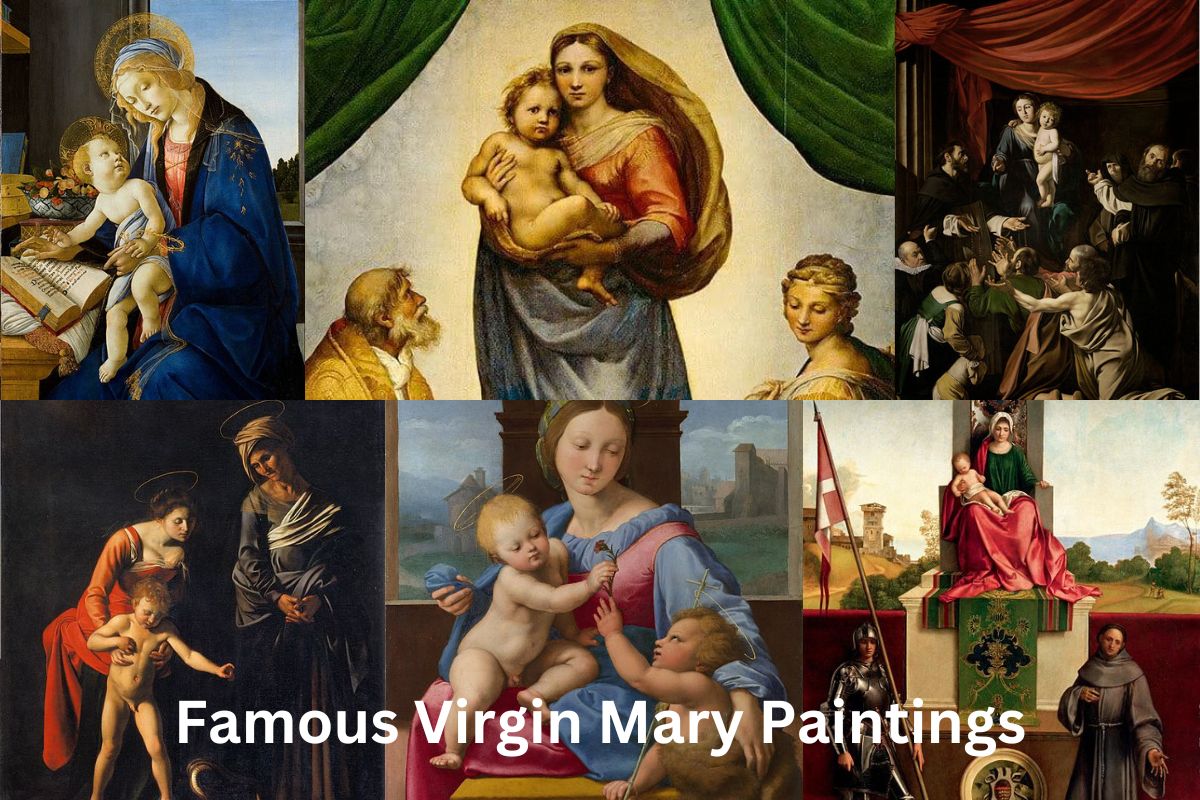Madonnas depict Mary, either by herself or with Jesus. Images like these play a vital role in the Orthodox and Catholic faiths. The Italian word ma donna, meaning “my lady,” is where we get this term (archaic). There are many examples of the Madonna and Child theme throughout Christian art.
During the late Middle Ages, the religion of the virgin and the art created to honor her rose to prominence, and these designations are a direct reflection of that.
Since the 13th century, when chivalry and aristocratic culture began to have a greater impact on poetry, song, and visual arts, the Madonna has frequently been depicted as the enthroned queen of heaven (see, for example, the Ognissanti Madonna).
The religious significance of Madonna’s virginity is designed to serve as a reminder to listeners. The color of her outfit also conveys this meaning. There were many connotations associated with the color blue, including those of chastity, virginity, and nobility.
Only the most prestigious of commissions would have been painted with ultramarine, as seen in the blue robes of the Virgin Mary in Gérard David’s Virgin and Child with Female Saints.
In the 17th century, Italian Renaissance art became synonymous with the name Madonna, which means “image or statue of the Virgin Mary” in English.
Famous Virgin Mary Paintings
1. Madonna of the Book – Sandro Botticelli
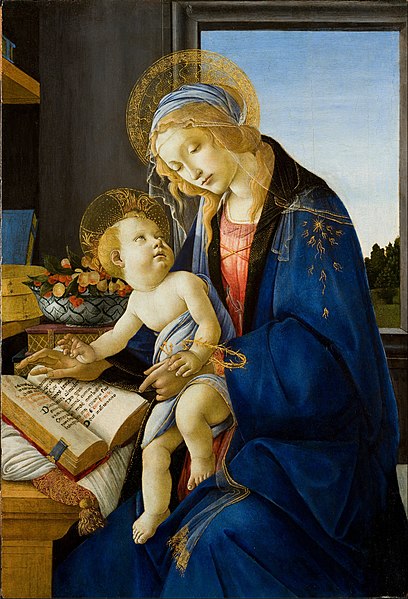
Sandro Botticelli’s Madonna of the Book, also known as the Madonna del Libro, is a miniature artwork that may be seen in Milan in the Poldi Pezzoli Museum. This artwork is a tempera painting on panel. It was made somewhere around 1480 or 1481.
A gentle and refined piece, “The Madonna of the Book” depicts the Virgin Mary and the Christ Child relaxing in a window seat. She is carrying a Book of Hours, namely a Horae Beatae Mariae Virginis, a common type of prayer book used by laity between the years 1300 and 1600.
While his mother is intently reading, her baby stares at her. Both the mother and son’s hands are open in a blessing pose, while the left ones are clasped together.
The Christ Child wears the crown of thorns and holds the three nails of the cross to represent Christ’s crucifixion. The likelihood is high that these were inserted at a later time in order to clarify the meaning. The standard depiction in Christian art.
Furthermore, the fruit in the bowl represents something significant. The plums symbolize the maternal love between Mary and Jesus, the cherries signify Christ’s blood or an allusion to paradise, and the figs are emblematic of the resurrection.
The blue robe Mary is commonly shown wearing is a sign of innocence, majesty, and heaven. Like the Madonnas in Botticelli’s other monumental series, the one seen here is solemn, reflective, and intent.
2. Sistine Madonna – Raphael
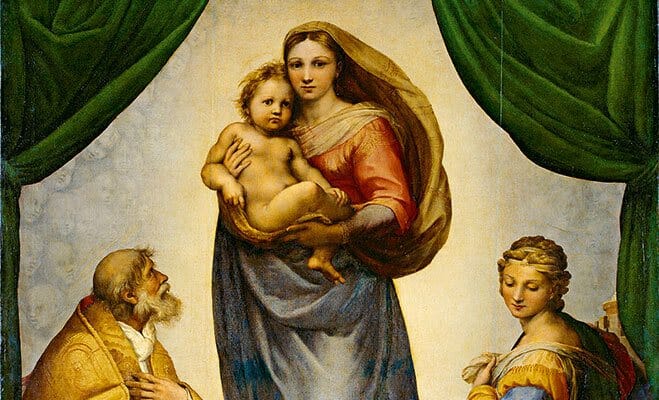
The Sistine Madonna was one of Raphael’s final great Renaissance masterpieces, and he passed away only a few years after he finished it.
Mary holds Jesus in her arms while Saints Sixtus and Barbara stand on either side of her in the painting. Below Mary, a group of cherubs stand and gaze above.
The picture was commissioned by the Benedictine monks of Piacenza’s San Sisto Monastery, who put it in a prominent location near the altar.
When it was given to the Saxon King Agustus III in 1754, it prompted a fierce debate regarding the relationship between art and religion in Germany.
After the war, the painting was sent to Moscow, and it wasn’t until 1955 that it was returned to Germany.
This image of the Virgin Mary is widely considered to be one of the most iconic images of the Holy Mother from the Renaissance due to its masterful use of light and shadow.
3. Madonna of the Magnificat – Sandro Botticelli
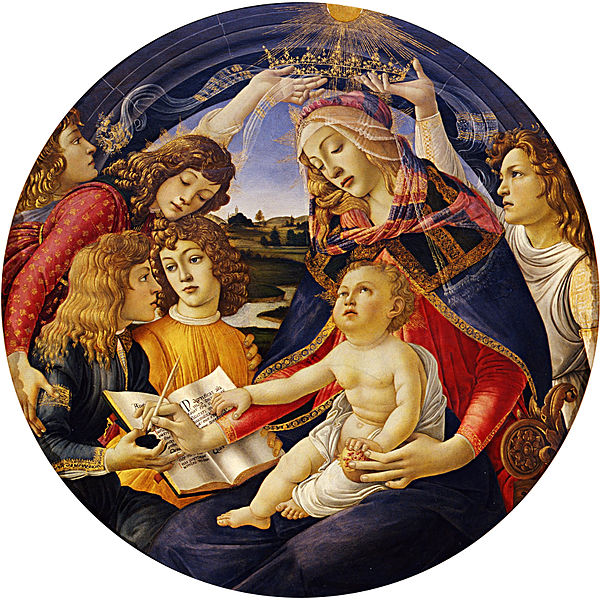
The Madonna of the Magnificat is a tondo-shaped painting by Italian Renaissance artist Sandro Botticelli depicting Mary in prayer.
Madonna del Magnificat was chosen since it referred to the work’s subject. Also known as The Virgin and Child Encircled by Five Angels.
The tondo depicts the Virgin Mary writing the Magnificat with her right hand while holding a pomegranate in her left. Jesus Christ is seated on her lap as two angels surround and crown her. It has recently been moved to the Uffizi Gallery in Florence, Italy.
The date and place of creation of this artwork are unknown, however it was purchased by the Uffizi Gallery from an anonymous collector in 1784. This innovation may have taken place in one of the many monasteries that Archduke Pietro Leopoldo had closed.
There are numerous iterations of the artwork, and you can see some of them in the Louvre and the Pierpont Morgan Library in New York City, to name just a couple of the world-famous institutions that house these variants.
The angel who was crowning Mary on the far left in the Louvre copy was removed so that the uppermost angel in the trio on the far left could spread his wings more dramatically.
4. Ghent Altarpiece – Hubert van Eyck and Jan van Eyck
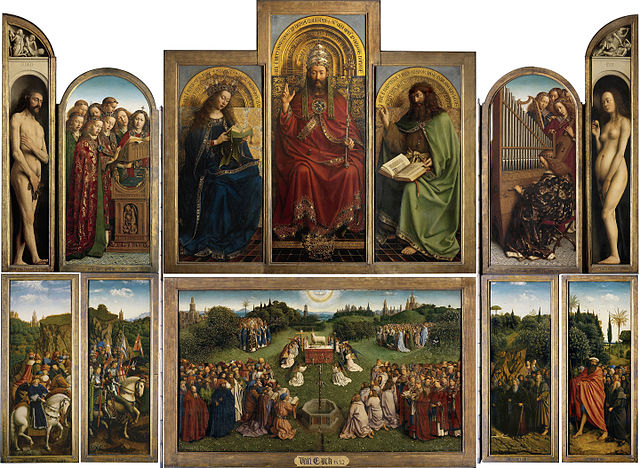
The polyptych painted by brothers Hubert and Jan van Eyck, in which each panel shows a prominent character or event from the Christian Old Testament or New Testament, is one of the most well-known works of art to have come out of the Dutch country.
Both vertically aligned layouts allow for the panels to be folded outward and combined in a wide variety of configurations.
A collaboration between two well-known Flemish men of the day resulted in this masterpiece.
While Hubert and Jan van Eyck did collaborate on numerous religious works after their 1432 masterwork, none were as well received.
The paintings are divided between the inner and outer panels of the two sets of folding wings that make up each of the two vertical registers.
The heavenly redemption depicted in the inner panels’ higher register features God (portrayed as Christ the King or God the Father), Mary, and John the Baptist in a classical Deisis grouping.
Mary opens a girdle book covered in green fabric. One of Mary’s titles is “Seat of Wisdom,” thus it makes sense that she would often be depicted with a book. This depiction of Mary may have been inspired by the one in Robert Campin’s Virgin Annunciate. She is dressed as a bride and has an open crown of flowers and stars.
5. Madonna Litta – Da Vinci
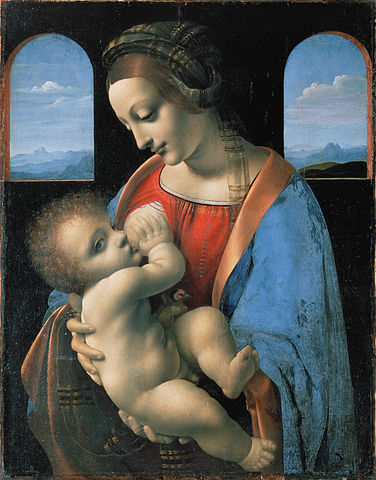
Leonardo da Vinci painted one of the most famous images of a mother and child from the Italian Renaissance.
Since the Renaissance occurred in Catholic-dominated Italy in the 1500s, many other painters also produced works featuring the Virgin Mary and the infant Jesus.
One of the most iconic Renaissance portrayals of Mary and Jesus is seen in a picture by Leonardo da Vinci titled Madonna Litta. In it, Mary is shown nursing a young Jesus. The duo are shown inside a castle that is perched on top of a mountain or hill, creating a striking contrast between light and dark.
Some art historians have cast doubt on the assumption that Da Vinci himself created this piece, arguing instead that one of his students, working under his supervision, was most likely responsible.
6. Madonna and Child with St. Anne – Caravaggio
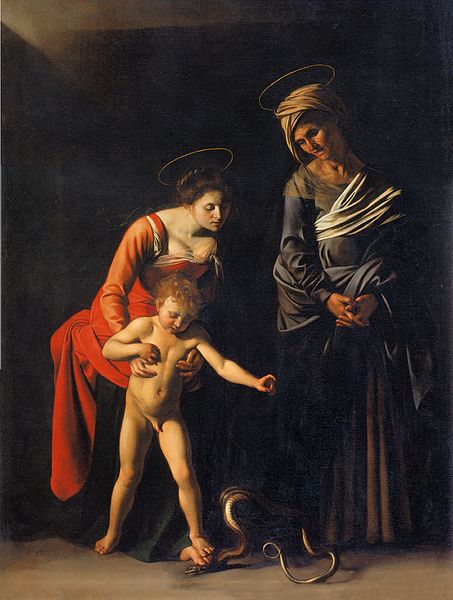
For the altar of the Archconfraternity of the Papal Grooms in the Basilica of Saint Peter, Caravaggio painted the Madonna and Child with St. Anne around 1605–1606.
The picture was removed from Sant’Anna dei Palafrenieri, the Vatican’s parish church, after a brief display, likely because of the controversy surrounding its unconventional depiction of the Virgin Mary.
Later, it found its way into the hands of Cardinal Scipione Borghese, who had it framed and hung in his palazzo (Galleria Borghese).
The arrangement isn’t his best work, but it shows a side of the Virgin that was probably unsettling to some modern audiences.
This allegory is, at its heart, quite straightforward. By leveraging her infant boy, the Virgin crushes the serpent that represents evil and original sin. The painting’s subject, the saintly Anne, appears as a wrinkly old grandma watching the scene unfold.
The righteous are crowned with flimsy halos, while the snake cowers beneath anti-halos. Mary and Jesus are both without shoes, and Jesus is a completely unclothed and uncircumcised infant. Almost everything else is in the dark, and the bright spots make the figurines stand out more dramatically.
7. Madonna della seggiola – Raphael
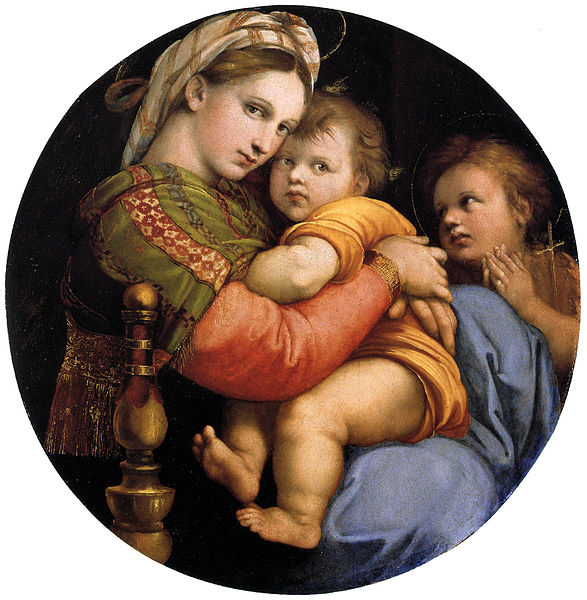
Between 1513 and 1514, Raphael finished a painting of the Virgin Mary he called The Madonna della Seggiola or The Madonna della Sedia. It is currently housed in the Palazzo Pitti Collection in Florence, Italy.
The Medici family, who have possessed the artwork since the 16th century, claim that they have forgotten who commissioned the work. Although the painting’s voyage to Palazzo Pitti has been recorded, the identity of the painting’s initial commissioner remains unknown.
Mary is shown sitting on a chair, with Jesus on her lap. There’s a young John the Baptist standing in the shadows, watching intently. Many of Raphael’s best-known works lists contain the Madonna della Sedia because of how highly it is thought of.
The artwork is notable for its accurate depiction of the Madonna as well as for Raphael’s use of the tondo compositional form.
8. Castelfranco Madonna – Giorgione
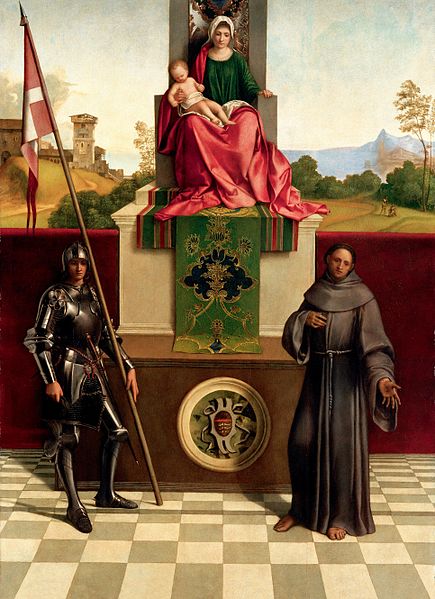
Giorgione, an Italian Renaissance painter, created The Madonna and Child Between St. Francis and St. Nicasius, also known as Castelfranco Madonna, in 1504.
Despite the fact that the current church it is housed in was built in the 18th century, the frescoes can still be seen in what is essentially their original setting: a side-chapel of the Cathedral of Castelfranco Veneto, Giorgione’s natal city in Veneto, northern Italy.
There is the Madonna enthroned with the child, St. Francis to the right, and St. Nicasius to the left; these are all hallmarks of the sacra conversazione genre.
When compared to similar works by Giovanni Bellini and others, in which the throne is just subtly elevated and the figures are nearly at the same level, the great height of this throne is most uncommon and provides a completely distinct effect.
One of just three paintings that have been positively identified as by Giorgione.
9. Aldobrandini Madonna – Raphael
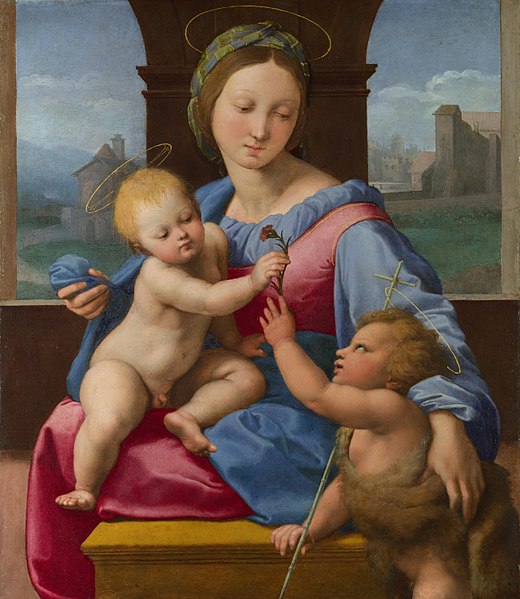
Dated to around 1509–1510, Raphael’s oil painting is known as the Garvagh Madonna (or the Aldobrandini Madonna).
Like many other paintings by Raphael, this one shows the Virgin Mary, the Christ Child, and the newborn John the Baptist.
The artist’s third, Roman, phase is characterized by a marked departure from the style and use of color characteristic of his Umbrian and Florentine periods, as well as the introduction of more natural subjects and locations.
Formerly in the possession of the Roman aristocratic Aldobrandini family for generations, the artwork has been part of the National Gallery in London’s collection since 1865. After almost half a century of ownership, Lord and Lady Garvagh sold it to the National Gallery in 1865.
10. Madonna of the Rosary – Caravaggio
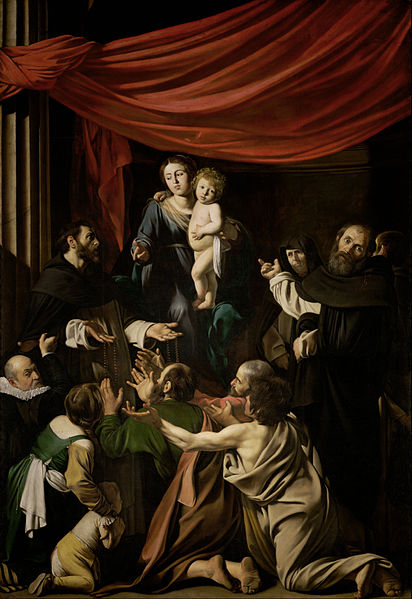
Caravaggio’s Madonna of the Rosary, completed in 1607, is currently on display at Vienna’s Kunsthistorisches Museum. This is the only Caravaggio work that fits the criteria for a typical Baroque altarpiece.
The Virgin Mary is depicted sitting on a throne and seemingly agreeing with Saint Dominic, who is shown here in full habit and holding a rosary. The devotees kneel before him for mercy, while a portrait of a donor dressed all in black and wearing a ruff may be seen off to the far left.
St. Peter Martyr, shown on the right, with a massive scar on his forehead (exactly like Caravaggio, who was wounded in the head a few months earlier in the altercation with Ranuccio Tommasoni and still had a noticeable scar) to represent the Virgin, who is absent from the scene. There are other Dominicans following closely behind him.

